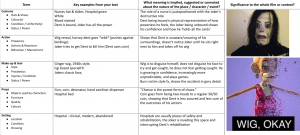When analysing a film it is important to understand the micro and macro features. The macro features are the genre, narrative & critical reception of the film. The micro features are the cinematography, editing, mise-en-scene and sound.
The sequence (embedded below) starts with the sound effect (T) of a train rushing by (E). This is effective as it instantly establishes the setting (A) – a poorer area of India, establishing the theme of poverty.
Later in the sequence there is some non-diegetic sound in the form of the film score. This happens when Jamal and Salim find the boy dressed as God Rama and the sounds of the riot fades out and is replaced by a version of the Who Wants To Be A Millionaire? score. This is effective as it acts as a bridge between present day and the past. It also places more emphasis on the God Rama, which is the subject of the question which started the flashback.

